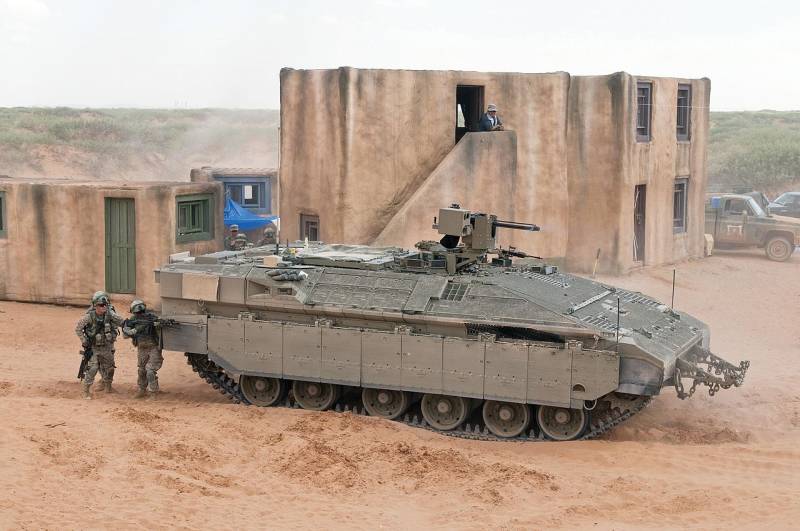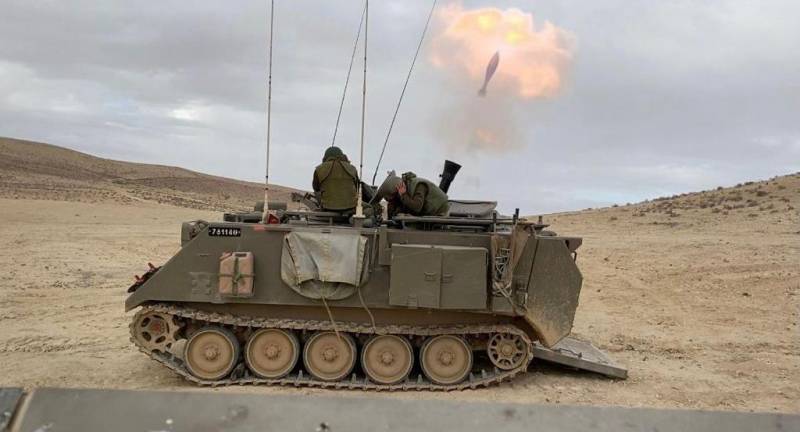Opportunities and risks for the IDF in ground operations

MBT "Merkava Mk 4"
After quite a long preparation, the Israeli armed forces have concentrated a large group of troops and forces near the borders of the Gaza Strip and are now beginning a ground operation. It is assumed that the formations and units involved in these activities have all the necessary capabilities to conduct combat in open areas and in urban environments. However, they should be expected to face a wide range of risks and restrictions in practice.
Troops and their structure
The ground forces of the Israel Defense Forces in peacetime have a strength of approx. 126 thousand people Of these, approx. 100 thousand are conscripts; the rest are contract military personnel, including officers and senior command personnel. The reserve, according to open data, numbers another 400 thousand people. Thus, mobilization was recently announced, during which they planned to increase the army by 300 thousand people.
The organizational and staffing structure of the IDF is built according to NATO patterns, but has its own characteristics. Thus, a limited number of units and formations are in permanent service, but there are a large number of reserve ones. If necessary, they should be restored in the shortest possible time due to mobilization and supplement the main formations.
T.N. The IDF infantry corps includes four linear mechanized brigades of various compositions, as well as airborne and special forces brigades. There are nine infantry brigades and four airborne brigades in reserve. The so-called tank frame. It has four “permanent” brigades and nine reserve ones. The artillery corps in peacetime is limited to three line regiments and one training regiment, which, if necessary, are reinforced by four reserve ones.

Heavy armored personnel carrier "Namer"
The activities of the main army formations are supported by auxiliary formations. The IDF has a number of engineering units, logistics units, intelligence structures, training units, etc.
According to current doctrines and regulations, IDF ground forces should not act alone, and they are supported by other branches and types of troops and forces. First of all, they can count on air support from the army or tactical aviation from the Air Force. In some cases, joint work with Navy ships or boats is possible.
Technical potential
As in other modern armies, the leading role in the IDF remains with tanks. According to The Military Balance 2023 directory and other open sources, line brigades now have about 400 Merkava armored vehicles of the latest modification Mk 4, including the modernized Mk 4M. There are about 200 of these MBTs, as well as approx. 700 older Mk 3 tanks are in reserve and intended for deployment during mobilization.
Infantry units and formations have approx. 1200 armored personnel carriers of various types. The most popular, despite all efforts, remain the old American M113 - approx. 500 units Available approx. 400 heavy armored personnel carriers on captured tank chassis of the latest modifications. The number of modern Namer armored personnel carriers does not yet exceed 290-300 units. At the same time, there are more than 5 thousand armored personnel carriers of various models in reserve, and these are mainly M113. Not long ago, deliveries of the modern Eitan armored vehicle began, but the number of such products is still insignificant.
Israeli motorized infantry has a completely standard set of weapons that allows it to solve various problems. Main rifle weapons are the M4 and Tavor automatic rifles. There are several types of machine guns of normal and large caliber. There are various anti-tank and anti-aircraft systems suitable for carrying by crew or transportation by any transport.

IDF rifle unit in the field
The total number of artillery, cannon and rocket, exceeds 500 units. It is based on 250 M109A5 self-propelled howitzers of 155 mm caliber. There are also several dozen self-propelled guns of 175 and 203 mm caliber in reserve. Towed artillery is represented only by 155-mm systems of obsolete types, some of which have long been put into reserve. There are towed, transportable and self-propelled mortars in calibers of 81, 120 and 160 mm - a total of up to 250 units.
The IDF's rocket artillery is represented by the American M270 and local Lynx systems - a total of at least 30 units. There are also about 90 systems of these and other types in reserve in calibers from 160 to 90 mm. If necessary, they can be returned to service.
Anti-tank and multi-purpose missile systems occupy a prominent place in the IDF's weapons system. To solve various combat missions, different guided missiles of the Spike family are used. Various modifications of such a complex with various capabilities and characteristics are in service. They are used in a portable version, on various equipment and as part of self-propelled systems.
The ground forces' own military air defense looks quite modest, because... The task of protecting against air attack is mainly solved by the Air Force. The military air defense is equipped with Makhbet anti-aircraft missile and gun systems with a 20-mm cannon and Stinger missiles. In addition, the FIM-92 Stinger MANPADS themselves are available in large quantities.
The combat work of linear formations and units is provided by auxiliary units with various types of equipment. First of all, these are engineering parts. For making passages, incl. in urban areas they have armored bulldozers. Also in service are repair, recovery and other armored vehicles. This is mainly foreign-made equipment.

Self-propelled mortar CARDOM
Obvious risks
The IDF has obvious technical, logistical and economic superiority over the enemy. However, as part of a major land operation, she will have to face a lot of difficulties and risks. Even with limited resources and capabilities, the enemy, represented by the Palestinian forces, has the ability to neutralize the advantages of the Israeli army and inflict significant blows on it.
The main problems are related to the specifics of the existing theater of military operations. IDF units will have to work in urban areas with all its features and dangers. The enemy will be able to set up barricades and ambushes, fire from the upper floors of buildings, and also use previously prepared underground communications. All these factors should lead to an increase in IDF losses in manpower and equipment, as well as to a decrease in the effectiveness of its actions.
Despite poor equipment and the absence of a number of classes of weapons and equipment, the Palestinian forces have everything they need to inflict painful blows on the enemy. In city conditions or underground tunnels, even conventional small arms used at short distances can be highly effective. Conditions are also improving for the successful use of any anti-tank weapons, ranging from rocket-propelled grenade launchers or even hand grenades.
Since the beginning of the current hostilities, Palestinian forces have been actively using unmanned attack systems based on available aircraft and ammunition. Despite their simplicity, such means have already caused the IDF certain losses and forced it to take additional measures to protect both individual combat units and troops as a whole.

Israeli soldiers study enemy underground communications
It should be recalled that in recent decades, when developing new armored vehicles, Israel has sought to ensure maximum protection, incl. from modern anti-tank weapons. Successful solution of such problems and obtaining high performance were claimed. However, the events of recent weeks have shown that the enemy has the ability to attack and successfully destroy Merkavas and other equipment. It is not difficult to understand how this situation will change if the fighting moves to the cities.
Operating in the Gaza Strip, Israeli ground forces rely on the support of army and tactical aviation. However, the small size of the theater, dense buildings and other factors create risks for the latter. Palestinian militants can organize ambushes with MANPADS that will interfere with aviation, inflict losses on it, and also indirectly worsen the capabilities of the IDF as a whole.
Experience and practice
Over the past decades, the IDF has accumulated extensive experience in conducting combat operations against armed groups with limited technical and logistical capabilities, both in open areas and in built-up areas. The Palestinian formations, in turn, also did not waste time, summarizing and analyzing the experience of fighting with the Israeli military. As the events of recent years show, both sides made conclusions and, on their basis, prepared for a new round of armed confrontation.
The IDF launches a full-scale ground operation in the Gaza Strip and aims to get rid of hostile Palestinian armed groups. They respond no less belligerently and threaten to destroy Israel. However, this time it is not statements that matter, but military potential and the ability to use existing opportunities. And it looks like both sides will be putting them on full display soon.
Information